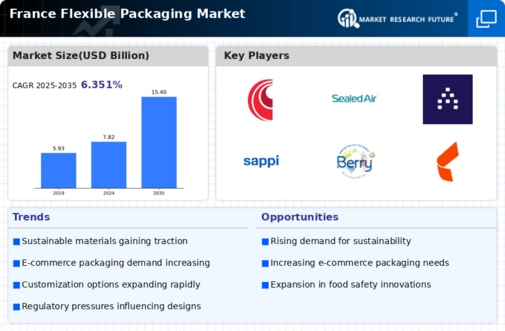Growth of the Food and Beverage Sector
The flexible packaging market in France is significantly influenced by the expansion of the food and beverage sector. With the increasing consumption of packaged foods, the demand for flexible packaging solutions rises correspondingly. Recent statistics indicate that the food and beverage industry constitutes over 50% of the total flexible packaging market. This growth is driven by factors such as changing dietary habits, urbanization, and a growing preference for convenience foods. As manufacturers seek to enhance product appeal and shelf life, innovations in flexible packaging materials and designs are likely to proliferate, thereby propelling the industry forward.
Rising Demand for Convenience Packaging
The flexible packaging market in France experiences a notable surge in demand for convenience-oriented solutions. Consumers increasingly favor products that offer ease of use, portability, and extended shelf life. This trend is particularly evident in sectors such as food and beverages, where ready-to-eat meals and single-serve packages gain traction. According to recent data, the convenience segment accounts for approximately 30% of the overall packaging market in France. As lifestyles become busier, the flexible packaging market adapts by providing innovative designs that cater to on-the-go consumption. This shift not only enhances consumer satisfaction but also drives manufacturers to invest in advanced materials and technologies, thereby fostering growth within the industry.
Consumer Preference for Aesthetic Appeal
In the competitive landscape of the flexible packaging market, aesthetic appeal emerges as a key driver influencing consumer choices. Brands increasingly recognize the importance of visually appealing packaging in attracting customers. This trend is particularly pronounced in sectors such as cosmetics and personal care, where packaging design can significantly impact purchasing decisions. Research indicates that products with attractive packaging can command a price premium of up to 15%. Consequently, manufacturers are investing in high-quality graphics and innovative designs to differentiate their products. This focus on aesthetics not only enhances brand loyalty but also contributes to the overall growth of the flexible packaging market.
Regulatory Support for Sustainable Practices
In France, the flexible packaging market benefits from a robust regulatory framework that encourages sustainable practices. The government has implemented various initiatives aimed at reducing plastic waste and promoting recycling. For instance, the Extended Producer Responsibility (EPR) scheme mandates that producers take responsibility for the entire lifecycle of their packaging. This regulatory environment incentivizes companies to adopt eco-friendly materials and processes, which could potentially lead to a 20% increase in the use of recyclable materials in flexible packaging by 2027. As a result, the industry is likely to witness a shift towards more sustainable packaging solutions, aligning with consumer preferences for environmentally responsible products.
Technological Innovations in Packaging Solutions
Technological advancements play a crucial role in shaping the flexible packaging market in France. Innovations such as smart packaging, which incorporates sensors and indicators, are gaining popularity among manufacturers. These technologies not only enhance product safety and quality but also provide valuable information to consumers. The integration of digital printing techniques allows for greater customization and shorter production runs, catering to the diverse needs of the market. As a result, the flexible packaging market is expected to witness a growth rate of approximately 5% annually, driven by these technological innovations that improve efficiency and sustainability within the industry.





















Leave a Comment